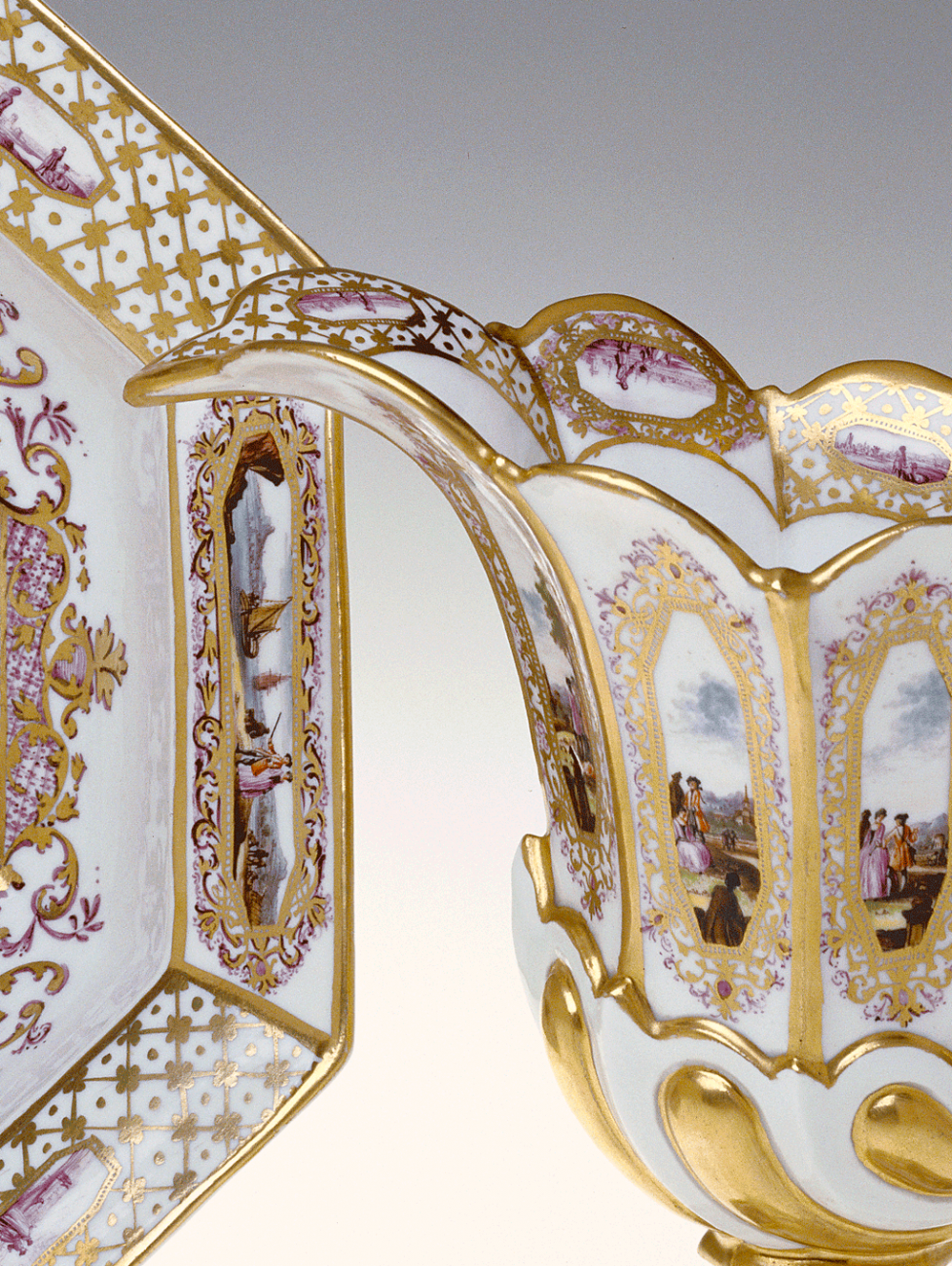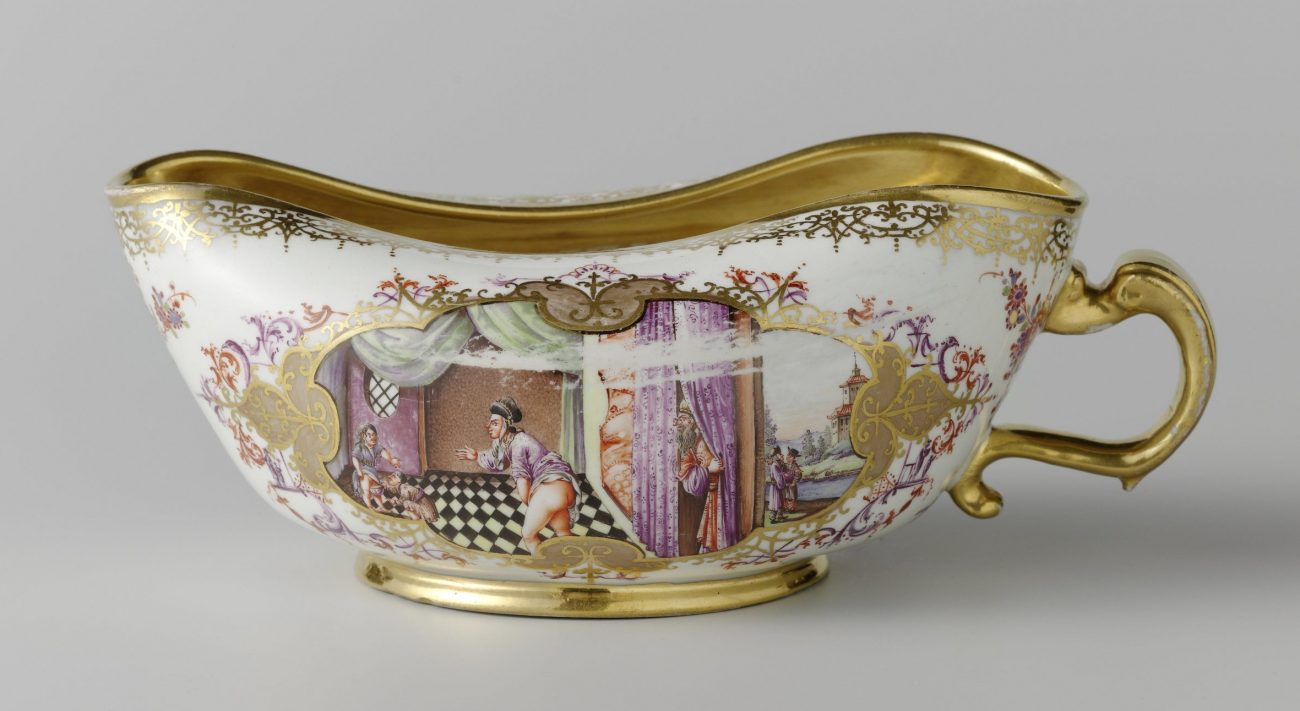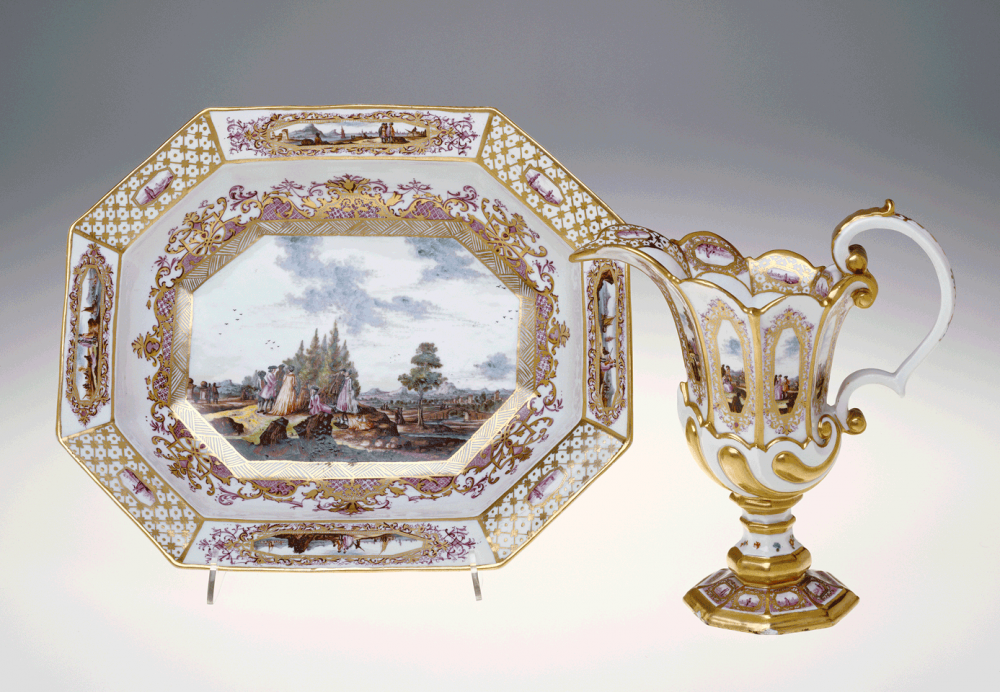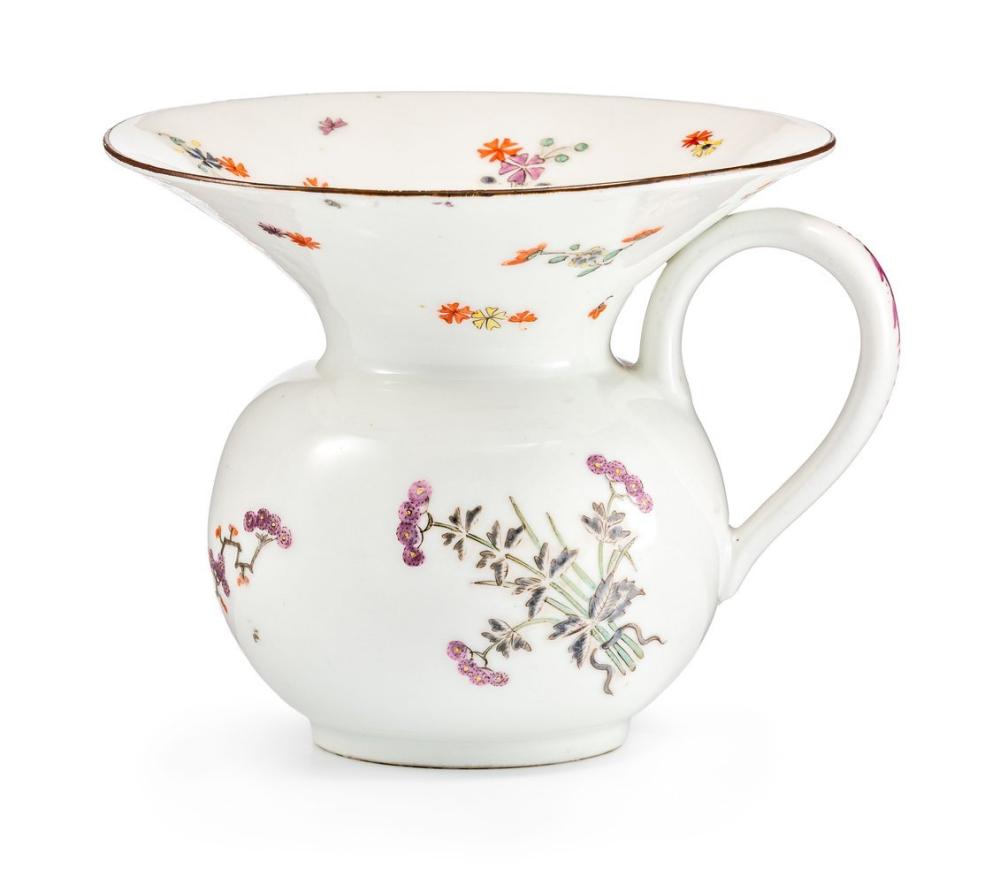Issue 5 2021 Short Essays
Early Meissen Porcelain as Decoration, Utility, and Health
Michael Greenberger

detail of Fig 2. Ewer and Basin, Meissen Manufactory, 1740, hard-paste porcelain, The J. Paul Getty Museum, 84.DE.918.
Europe’s first hard-paste porcelain, Meissen porcelain, changed the aesthetics and interpretation of ceramics in the West during the eighteenth century. These white glazed tableware pieces and figures acted not only as aesthetically pleasing table decorations, but also as a way for the aristocracy to display pride in scientific achievement.1 The wares of the Meissen manufactory, established in Saxony in 1710, became a form of propaganda that reinforced the prestige of its monarch Augustus II, the Strong (1670-1733). This status in part could be attributed to advancements in medicine and hygiene in the eighteenth century. Three examples of Meissen porcelain discussed here may be seen as “social actors” in that they demonstrate awareness of bodily needs and concerns.2 As Stacey Sloboda writes: “Things collected, given, and displayed were part of networks of exchange that bridged the categories of public and private.”3
Since its early importation from China in the sixteenth century, which is attributed to Marco Polo (1254-1324), porcelain had social and hygienic implications. The Chinese had dominated its commerce since their invention of the substance in the Tang Dynasty (618–907). The mystery surrounding how the material was made contributed to mystical and fantastical interpretations of its properties and its valuation. Indeed, porcelain was sometimes valued as highly as gold.4 It was common to believe that any poison that came into contact with porcelain would become defective. Porcelain was believed to shatter from the poison, which caused many pieces of porcelain to be mounted with metal to protect it from such danger.5
Porcelain was often kept in the Wunderkammer, or cabinet of curiosities, which became popular in Europe in the mid-sixteenth century.6 In these collections, single porcelain cups or dishes were displayed amongst scientific examples of artifacts considered rare, unusual, and worthy of study. Much of porcelain’s attraction came from speculation on its properties.
What was not speculative was the fact that porcelain was non-porous. Porosity was something about which European society was extremely anxious in the seventeenth and eighteenth centuries. The public was particularly worried about bathing, since hot water was thought to cause the pores to open, allowing bacteria to enter.7 The fact that porcelain did not have this porosity and could withstand high temperatures became well known at the time and allayed such fears.8
Theories about health became especially significant in the seventeenth century as a result of the bubonic plague that killed thousands during the Vienna epidemic of 1675-1683 and would in 1680 affect the state of Saxony. Europe looked for any form of remedy.9 Tea, a commodity like porcelain often imported from Asia, was considered to be a cure for anything from headaches to scurvy.10 Having porcelain associated with tea and natural healing made the white clay immensely desirable. Augustus II, the Strong, became so obsessed with collecting pieces of porcelain that he is said to have had Porzellankrankheit or porcelain disease–a mania to own it. Driven to uncover how the substance was made, the monarch kept Johann Friedrich Böttger (1682-1719), an alchemist, his prisoner. Along with Ehrenfried Walther von Tschirnhaus, Bottger’s mentor, a mathematician, physicist, and physician, Böttger found the formula for the material and produced true hard-paste porcelain on European soil for the first time in 1710, virtually changing the market forever.11 Augustus II capitalized on his ownership of the white clay. As the medieval use of fingers for dining was transitioning to utensils, porcelain became a material synonymous with sophisticated table practice. The manufactory started to produce thousands of table articles for which they became renowned. The manufactory, however, also produced unexpected object–types that display interest in health and hygiene with reference to bodily demeanor.

Fig. 1 Bourdeloue, Meissen Manufactory, 1730-35, hard-paste porcelain, Rijksmuseum, BK-17439. Courtesy of Rijksmuseum, Amsterdam.
A Meissen bourdaloue in the Rijksmuseum is an example of European etiquette combined with Asian influences (Fig. 1). The bourdaloue, or chamber pot, was supposedly an invention of convenience. Louis Bourdaloue, a Jesuit preacher, is said to have given sermons so long that women would struggle to sit through them without needing a toilet.12 The bourdaloue made it possible to relieve oneself but at the same time the act of using it was a semi-public display of appropriate healthful behavior.13 The pot here is set into an undulating oval form and has a Chinese-style handle to one end. The inside of the chamber pot is covered with the thick gilding that Meissen often used. The outside border has the delicate lace gilding associated with manufactory at this time. Both sides are decorated with chinoiserie scenes in a cartouche surrounded by polychrome enamel and a lustered border. Meissen produced several generic pot-form bourdaloue, but what makes this bourdaloue distinct is the central decoration on the outside of the piece, which contains a painting attributed to Philipp Ernst Schindler (1695-1765), a student of Johann Gregorius Höroldt (1696-1775.)14 In the foreground is a partially nude woman who is gesturing to a figure set back in the to the left. The background figure, like the central figure, is partially undressed and is being assisted by a man to use a chamber pot. Most painted scenes of chinoiserie on Meissen take place outdoors, with three or four figures partaking in tea or other leisurely activities. Very rarely do we see such a private and personal scene as the use of a chamber pot. Indeed, the scene, like many eighteenth-century paintings of women at toilette, has evident erotic appeal given the man spying on the women from behind a curtain at the right. It is also striking that the scene is being enacted by Asian characters when, in fact, the bourdaloue was not a commonly used object in the East. The decoration is Chinese in style, but the instrument itself is a European invention such that the whole might be described, using David Porter’s language, as “a promiscuous melding of incongruities.”15 The narrative displays and satirizes the seductions of the indisposed body ironically juxtaposed to the evident beauties and cleanliness of porcelain. The Meissen bourdaloue acts not only as a symbol of hygiene, but also as a performative object.16

Fig. 2 Ewer and Basin, Meissen Manufactory, 1740, hard-paste porcelain, The J. Paul Getty Museum, 84.DE.918.
A second example of porcelain that speaks to the body and hygiene is a Meissen ewer and basin in the collection of the J. Paul Getty Museum in Los Angeles (Fig. 2). The helmet-shaped ewer’s body is replicating metal work with the columnar stem leading to quatrelobe paneling, each with cartouche Watteau-esque paintings. The handle is a replication of those seen in Arita ware which were imported from Japan. The basin is octagonal in shape, possibly copying Chinese saucers and it features a central leisurely scene. The ewer and basin were used for hand washing since the fifteenth century. As previously stated, fingers were used for dining during the medieval period, so hand washing was both a necessary and performative act.17 However, in the eighteenth century such ewers and basins as this one by Meissen were mostly presentational. It often belonged in the accoutrement of the toilet, where it stood out as both art and status rather than for its utility. Meissen adapted what was once an everyday object indicative of healthful practice and elevated it by application of its lustrous materiality.

Fig. 3 Spittoon, Meissen Manufactory, 1730-35, hard-paste porcelain, private collection. Courtesy of Leo Spik.
The final example is a Meissen spittoon recently at auction at Leo Spik in March of 2021 (Fig. 3). A spittoon is an object type used to expel saliva in a polite fashion. The body of this spittoon is in the shape of a small oval that flutes out like a trumpet vase. The handle is long while the object itself is quite small. It is decorated with Kakiemon emblems and like the bourdaloue displays a dichotomy between European invention and Eastern decoration. Spittoons in this period, like the ewer and basin, would have largely representational value solidifying the argument that Meissen adopted these designs and creations less for function than for display. The bourdaloue, the ewer and basin, and the spittoon push forward a narrative and aesthetic of health that argue for the sophistication of German/Saxon society so integral and apparent given their appearance in Meissen porcelain.
Meissen porcelain in the early eighteenth century symbolically materialized wealth and cleanliness. In actuality porcelain itself had very few healthful benefits, but the Saxon monarch Augustus II used it effectively to enhance his own image. He did so by displaying artifacts of Meissen as icons of not only social prestige but also advancements in hygienic practice.
is a student in the History of Design and Curatorial Studies MA program offered jointly by Parsons School of Design and Cooper Hewitt, Smithsonian Design Museum. He is a fellow in the Decorative Arts department of the museum and is an active collector of eighteenth-century Meissen Porcelain. His master’s thesis will explore how sculptural and architectural elements were brought from the outside and onto the tabletop during the eighteenth century through Meissen porcelain.
Notes
- Stacey Sloboda, “Displaying Materials: Porcelain and Natural History in the Duchess of Portland’s Museum,” Eighteenth-Century Studies, 43, no. 4 (Summer 2010): 468.
- Mimi Hellman, “Furniture, Sociability, and the Work of Leisure in Eighteenth-Century France,” Eighteenth-Century Studies, 32, no. 4 (Summer 1999): 417.
- Sloboda, “Displaying Materials,” 458.
- Rolad Hoffmann, “Meissen Chemistry,” American Scientist 92, no. 4 (2004): 313.
- Jan van Campen and Titus M. Eliëns, Chinese and Japanese Porcelain for the Dutch Golden Age (Zwolle: Waanders Uitgevers, 2014), 222.
- Patrick Mauriès, Cabinets of Curiosities (New York: Thames & Hudson, 2002); See also Sloboda, “Displaying Materials,” 458.
- Mimi Hellman, “Of Water and Chocolate,” Gastronomica 4, no. 4 (2004): 11.
- Norbert Elias, The Civilizing Process: The History of Manners (New York: Urizen Books, 1978), 117-129.
- Edward A. Eckert, “The Retreat of Plague from Central Europe, 1640-1720: A Geomedical Approach,” Bulletin of the History of Medicine 74, no. 1 (2000): 15.
- Ibid.
- John Sandon, Meissen Porcelain (New York: Osprey Pub., 2010) 14.
- Elizabeth Williams, et al, Daily Pleasures: French Ceramics from the Mary Lou Boone Collection (Los Angeles: Los Angeles County Museum of Art, 2012), 296, entry by Meredith Chilton.
- Wall text, Chamber Pot (Bourdaloue), 82.DE.9, The Getty Center, Los Angeles.
- Stefan Bursche, “Philipp Ernst Schindler und das hohle Dreieck,” Keramos 161, (1998): 18-21.
- David L. Porter, “Monstrous Beauty: Eighteenth-Century Fashion and the Aesthetics of the Chinese Taste,” Eighteenth-Century Studies, 35, no. 3 (Summer 2002): 395-411.
- Mimi Hellman, “Furniture, Sociability,” 417.
- Norbert Elias, The Civilizing Process, 117-129.
